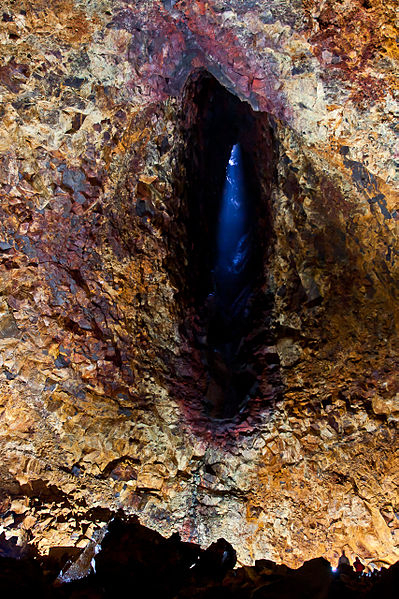Thrihnukagigur Volcano is a dormant volcano located approximately 13 miles (20 km) southeast of Reykjavik, Iceland. Also known as “Three Peaks Crater,” Thrihnukagigur last erupted more than 4,000 years ago. It is now notable for its vast, empty magma chamber.
While most underground magma chambers are naturally sealed off by cooled and hardened lava, the magma beneath Thrihnukagigur evidently drained away, perhaps to a spot deeper within the earth. A caver discovered the volcano’s magma chamber in 1974. It was opened to the public in 2012, making Thrihnukagigur the only volcano in the world that visitors can explore from the inside.
 The enormous cavern is taller than the Statue of Liberty, and nearly as wide as three full-sized basketball courts lined up end-to-end. The walls are covered with intricate rock formations and bright colors. Yellow stains are attributable to sulfurous gases, while blue indicates where rocks have detached from the wall.
The enormous cavern is taller than the Statue of Liberty, and nearly as wide as three full-sized basketball courts lined up end-to-end. The walls are covered with intricate rock formations and bright colors. Yellow stains are attributable to sulfurous gases, while blue indicates where rocks have detached from the wall.
Tourism
Tourists can take an open cable car through the cinder cone peak and descend 120 meters (400 feet) to the bottom of the underground chamber. However, due to the absence of roads in that area, visitors must first hike to the volcano from the foot of the Bláfjöll mountains. The trek involves a 45-minute hike over lava fields each way.
Volcanic Iceland
Iceland is the world’s largest volcanic island, due to its location on the Iceland Hotspot and the Mid-Atlantic Ridge, an underwater mountain range bordering the crack where the North American and Eurasian tectonic plates are pushing away from each other. As the crack between the plates expands, lava periodically escapes from it, rises to the surface of the sea, and hardens, creating new land. This process is slowly enlarging Iceland. The Thrihnukagigur Volcano sits at the center of this ridge.
The country has a high number of active volcanoes, including Eyjafjallajokull, whose 2010 eruption halted air travel throughout Europe. Thanks to its abundant volcanic activity, Iceland generates more than a quarter of its electricity from geothermal energy.
Learn more about volcanoes.
Learn more about ocean basins and the Mid-Atlantic Ridge.
Photo credit: View from bottom of Thrihnukagigur Crater. Olikristinn. Wikimedia Commons. Creative Commons License.